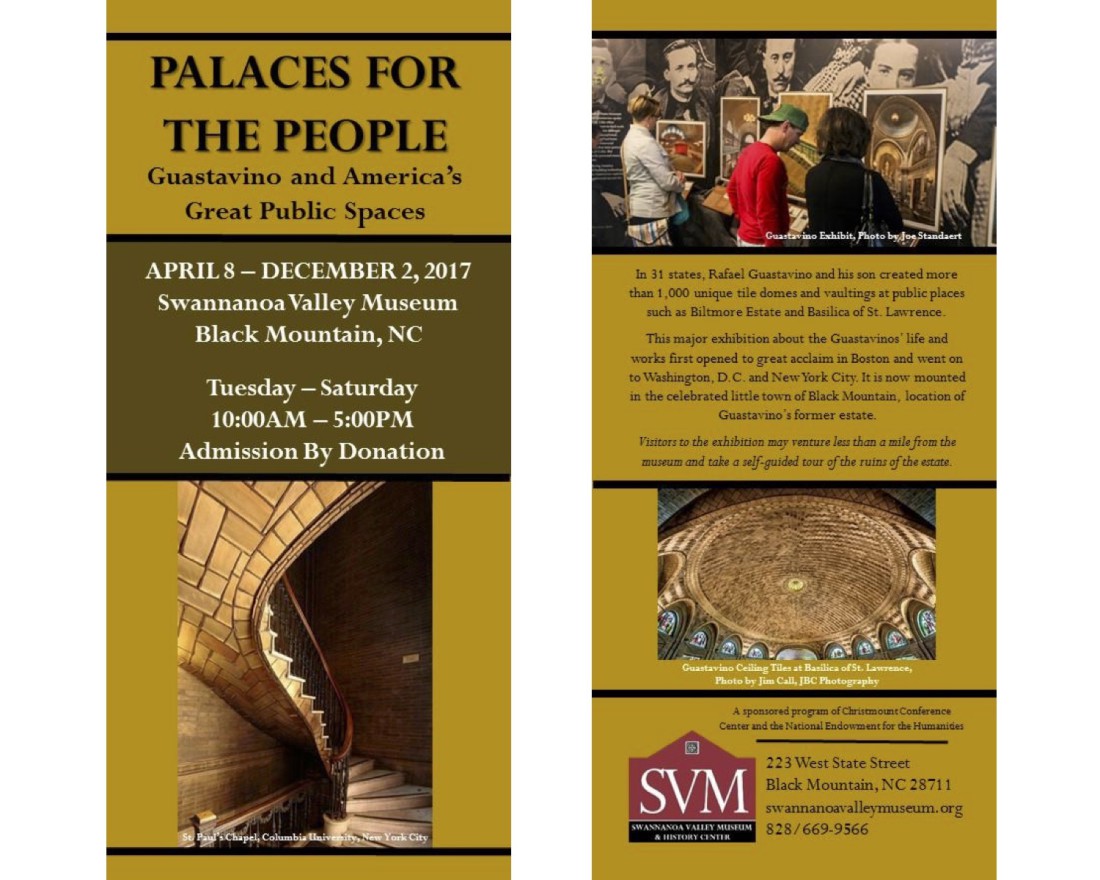Press release:
From 1882 to l943, in 31 states, 10 in North Carolina, and 6 countries, Rafael Guastavino and his son Rafael Jr., created more than 1,000 Catalan tile domes and vaultings that met their criteria of speed, health, safety, and beauty.
“Palaces For The People: Guastavino And America’s Great Public Spaces” is an exhibition about their lives and works that opened to great acclaim in Boston, then moved to Washington, D. C. and New York City, and opened April 8 in the celebrated little town of Black Mountain, North Carolina, location of Guastavino Sr.’s former estate.
The exhibition opened in the Swannanoa Valley Museum on April 8 and will run nine months, closing December 1, 2017.
The museum is at 223 West State Street. The hours are 10 to 5 Tuesday-Saturday. Admission is by donation.
The exhibition has been a great success, attracting around 2,000 visitors in the first six weeks. It may travel to Barcelona, Spain. Other possibilities are cities in North Carolina, Winston-Salem, Chapel Hill, Durham, Wilmington, Davidson, and Greensboro where work by the Guastavinos may be seen.
A native of Valencia, Spain, Rafael Guastavino Sr., then 40 years old, arrived in New York with his 9-year-old son Rafael III in 1881. He had been so successful as a master architect and tile artist in Spain in the era of Gaudi that he brought with him 40,000 dollars, a great sum for an immigrant in those days.
After many high and low points, he achieved his first great success in his adopted country by creating tile vaultings and ceilings throughout the new Boston Public Library using a unique, secret fire proof sealing compound.
Awareness grew of Guastavino’s fine works in various types of buildings, several listed twice among the country’s ten greatest.
George Vanderbilt contracted him to bring his talent for tile vaulting into major areas of the Biltmore Estate under construction in Asheville, North Carolina. Guastavino’s unique expertise may be seen in the Biltmore House atrium’s tiled vaults and dome and in the celebrated basement swimming pool. The Biltmore is lending artifacts to the exhibition.
Guastavino was so inspired by the mountain spectacles in and around Black Mountain that he bought 1,100 acres. Ironically, the great tile and brick artist built his house of wood from trees on his property. He built several brick kilns, and he became a wine maker. An accomplished writer, violinist, pianist, and composer, he often played for family and friends. His fondness for women got him into trouble with his three wives.
Visitors to the exhibition may venture a mile from the museum and take a self-guided tour of the romantic ruins of Guastavino’s Estate. The site now belongs to Christmount Conference Center in Black Mountain. The creator of the exhibition donated all the materials to Christmount. Plans are underway to built a Guastavino museum there.
Unable to find a seat in the tiny Catholic Church in Asheville, Guastavino senior built his last great structure, the Basilica of St. Lawrence. The dome is the largest free-standing elliptical dome in North America. The master builder is buried under that dome.
Rafael, Jr. carried on the tile business, adding impressive ornamentation in his own creations, such as the Oyster Bar in Grand Central Station in New York. He was an innovator in acoustic tile. He sold the company in 1943; he died in 1950; the company closed in 1962.
Among the many father and son achievements that may be seen are the National Cathedral in Washington, the Queenboro Bridge Food Emporium, the Reception Hall at Ellis Island, The Nebraska State Capitol building, the Smithsonian, Carnegie Hall, and Grant’s Tomb.
Truly palaces open to the people, for more than a century, their works included colleges; zoos; memorials; theaters; courthouses; restaurants; train terminals; subway stations; and government, business, and hotel buildings.
Four major artifacts from his estate have been added to the exhibition in Black Mountain: an enormous iron bell, a huge exotic fountain, a four-piece parlor set rescued from a fire in the house and restored, and the black dress Guastavino’s widow Francesca wore throughout four decades.
The exhibition is a co-operative venture of Christmount and St. Lawrence Basilica, with limited participation by Biltmore Estates.
In connection with the exhibit, there will be conferences, lectures, performances, and other exhibits in Black Mountain, Asheville, and around the nation, involving tile artisans, architects, engineers, musicians, artists, poets, and actors.




Before you comment
The comments section is here to provide a platform for civil dialogue on the issues we face together as a local community. Xpress is committed to offering this platform for all voices, but when the tone of the discussion gets nasty or strays off topic, we believe many people choose not to participate. Xpress editors are determined to moderate comments to ensure a constructive interchange is maintained. All comments judged not to be in keeping with the spirit of civil discourse will be removed and repeat violators will be banned. See here for our terms of service. Thank you for being part of this effort to promote respectful discussion.